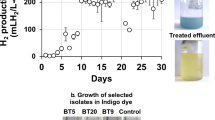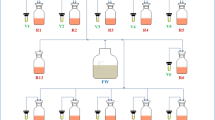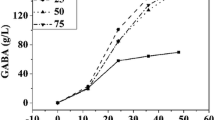Abstract
Shewanella oneidensis has demonstrated excellent potential for azo dye decolorization and degradation. However, in anaerobic environments, S. oneidensis has a narrow carbon source spectrum, which requires additional electron donors, such as sodium lactate. This increases the practical application costs for wastewater treatment. Here, we aimed to expand the carbon source utilization range of S. oneidensis FJAT-2478 by co-culturing it with Lactobacillus plantarum FJAT-7926, leveraging their commensalism relationship to develop a metabolic chain. Results showed that a 1:2 initial ratio of L. plantarum FJAT-7926 to S. oneidensis FJAT-2478 achieved a 97.16% decolorization rate of methyl orange when glucose served as the sole carbon source. This co-culture system achieved a decolorization rate comparable to that obtained using sodium lactate as an electron donor and was significantly higher than that achieved by L. plantarum FJAT-7926 (7.88%) or S. oneidensis FJAT-2478 (6.89%) alone. After undergoing five cycles, the co-culture system continued to exhibit effective decolorization. It was demonstrated that the co-culture system could use common and inexpensive carbon sources, such as starch, molasses, sucrose, and maltose, to decolorize azo dyes. For instance, 100 mg/L methyl orange could be degraded by over 98.05% within 24 h. The results indicated that the degradation rates of methyl orange were higher when L. plantarum was inoculated first, followed by a subsequent inoculation of S. oneidensis after 2 h. The co-culturing of L. plantarum FJAT-7926 and S. oneidensis FJAT-2478 proved to be an effective strategy in treating azo dye wastewater, expanding the potential practical applications of S. oneidensis.




Similar content being viewed by others
References
Ameen FA, Hamdan AM, El-Naggar MY (2020) Assessment of the heavy metal bioremediation efficiency of the novel marine lactic acid bacterium, Lactobacillus plantarum MF042018. Sci Rep 10:314. https://doi.org/10.1038/s41598-019-57210-3
Barchinger SE, Pirbadian S, Sambles C, Baker CS, Leung KM, Burroughs NJ, El-Naggar MY, Golbeck JH (2016) Regulation of gene expression in Shewanella oneidensis MR-1 during electron acceptor limitation and bacterial nanowire formation. Appl Environ Microbiol 82:5428–5443. https://doi.org/10.1128/AEM.01615-16
Beblawy S, Bursac T, Paquete C, Louro R, Clarke TA, Gescher J (2018) Extracellular reduction of solid electron acceptors by Shewanella oneidensis. Mol Microbiol 109:571–583. https://doi.org/10.1111/mmi.14067
Bhakta JN, Ohnishi K, Tsunemitsu Y, Ueno D, Manna K (2022) Assessment of arsenic sorption properties of lactic acid bacteria isolated from fecal samples for application as bioremediation tool. Appl Water Sci 12:116. https://doi.org/10.1007/s13201-022-01634-2
Cheng L, Min D, He RL, Cheng ZH, Liu DF, Yu HQ (2020) Developing a base-editing system to expand the carbon source utilization spectra of Shewanella oneidensis MR-1 for enhanced pollutant degradation. Biotechnol Bioeng 117:2389–2400. https://doi.org/10.1002/bit.27368
Cui MH, Liu WZ, Tang ZE, Cui D (2021a) Recent advancements in azo dye decolorization in bio-electrochemical systems (BESs): insights into decolorization mechanism and practical application. Water Res 203:117512. https://doi.org/10.1016/j.watres.2021.117512
Cui YH, Wang MH, Zheng YH, Miao K, Qu XJ (2021b) The carbohydrate metabolism of Lactiplantibacillus plantarum. Int J Mol Sci 22:13452. https://doi.org/10.3390/ijms222413452
Elsanhoty RM, Al-Turki IA, Ramadan MF (2016) Application of lactic acid bacteria in removing heavy metals and aflatoxin B1 from contaminated water. Water Sci Technol 74:625–638. https://doi.org/10.2166/wst.2016.255
Espinosa-Ortiz EJ, Rene ER, Gerlach R (2021) Potential use of fungal-bacterial co-cultures for the removal of organic pollutants. Crit Rev Biotechnol 42:361–383. https://doi.org/10.1080/07388551.2021.1940831
Guy M, Mathieu M, Anastopoulos IP, Martinez MG, Rousseau F, Dotto GL, de Oliveira HP, Lima EC, Thyrel M, Larsson SH et al (2022) Process parameters optimization, characterization, and application of KOH-activated norway spruce bark graphitic biochars for efficient azo dye adsorption. Molecules 27:456. https://doi.org/10.3390/molecules27020456
He J, Zhang K, Wang L, Du YC, Yang Y, Yuan C (2022) Highly efficient degradation of cypermethrin by a co-culture of Rhodococcus sp. JQ-L and Comamonas sp. A-3. Front Microbiol 13:1003820. https://doi.org/10.3389/FMICB.2022.1003820
Hong YG, Gu JD (2010) Physiology and biochemistry of reduction of azo compounds by Shewanella strains relevant to electron transport chain. Appl Microbiol Biotechnol 88:637–643. https://doi.org/10.1007/s00253-010-2820-z
Hui W, Elon C, Warwick BD, Catherine LW, Royston G, Jonathan RL (2013) Metabolomic analyses show that electron donor and acceptor ratios control anaerobic electron transfer pathways in Shewanella oneidensis. Metabolomics 9:642–656. https://doi.org/10.1007/s11306-012-0488-3
Jia W, Shiqi Z, Xin F et al (2013) Research of carbon source utilization by Lactiplantibacillus plantarum AR113. Food Ferment Ind. https://doi.org/10.13995/j.cnki.11-1802/ts.033445
Kasai T, Kouzuma A, Watanabe K (2017) CRP regulates D-lactate oxidation in Shewanella oneidensis MR-1. Front Microbiol 8:869. https://doi.org/10.3389/fmicb.2017.00869
Lei X, Huahua J, Xiang X (2017) Deep-sea bacterium Shewanella piezotolerans WP3 has two dimethyl sulfoxide reductases in distinct subcellular locations. Appl Environ Microbiol 83:e01262-e1317. https://doi.org/10.1128/AEM.10262-17
Li F, Li Y, Sun L, Li X, Yin C, An X, Chen X, Tian Y, Song H (2017) Engineering Shewanella oneidensis enables xylose-fed microbial fuel cell. Biotechnol Biofuels 10:196. https://doi.org/10.1186/s13068-017-0881-2
Li F, Yin C, Sun L et al (2018) Synthetic Klebsiella pneumoniae-Shewanella oneidensis consortium enables glycerol-fed high-performance microbial fuel cells. Biotechnol J 13(5):e1700491. https://doi.org/10.1002/biot.201700491
Li C, Gao M, Zhu W, Wang N, Ma X, Wu C, Wang Q (2021) Recent advances in the separation and purification of lactic acid from fermentation broth. Process Biochem 104:142–151. https://doi.org/10.1016/j.procbio.2021.03.011
Long ML, Zhu X, Li FB, Wu YD (2022) Impact of culture conditions on the biofilm and cell morphology of Shewanella oneidensis MR-1. Acta Microbiol Sin 62:2265–2276. https://doi.org/10.13343/j.cnki.wsxb.20210526
Lu M, Chan S, Babanova S, Bretschger O (2017) Effect of oxygen on the per-cell extracellular electron transfer rate of Shewanella oneidensis MR-1 explored in bioelectrochemical systems. Biotechnol Bioeng 114:96–105. https://doi.org/10.1002/bit.26046
Maulin PS (2014) Exploited application of Lactobacillus in microbial degradation and decolorization of acid orange. Int J Environ Biorem Biodegrad 2:160–166. https://doi.org/10.12691/ijebb-2-4-3
Pandey A, Singh P, Iyengar L (2006) Bacterial decolorization and degradation of azo dyes. Int Biodeterior Biodegrad 59:73–84. https://doi.org/10.1016/j.ibiod.2006.08.006
Ramzan U, Shakoori FR, Zahid MT, Majeed W, Zahra I, Abbas SZ, Hedfi A, Hassan S, Shakoori AR, Mutery AA (2022) Biodegradation and decolorization of textile azo dyes by Paramecium caudatum isolated from industrial wastewater. Water 14:3553. https://doi.org/10.3390/w14213553
Shan Y, Lai Y, Yan AX (2012) Metabolic reprogramming under microaerobic and anaerobic conditions in bacteria. Subcell Biochem 64:159–179. https://doi.org/10.1007/978-94-007-5055-5_8
Sofu A (2019) Investigation of dye removal with isolated biomasses from whey wastewater. Int J Environ Sci Technol (tehran) 16:71–78. https://doi.org/10.1007/s13762-018-1977-3
Tao M, Jin C, Lu H et al (2022) Living and regenerative material encapsulating self-assembled Shewanella oneidensis-CdS hybrids for photocatalytic biodegradation of organic dyes. Microorganisms 10:2501. https://doi.org/10.3390/microorganisms10122501
Thomas P (2013) Overview on toxicity and exposure to azo dyes and aromatic amines. Toxicol Lett 221:S53. https://doi.org/10.1016/j.toxlet.2013.06.193
Thuan NH, Tatipamula VB, Canh NX, Van Giang N (2022) Recent advances in microbial co-culture for production of value-added compounds. 3Biotech 12:115. https://doi.org/10.1007/s13205-022-03177-4
Tu J, Lu CC, Chen Z, Zhang Q, Song YY, Li HB, Han Y, Hou Y, Guo JB (2022) Protective effect of β-cyclodextrin to microorganisms during anaerobic degradation of azo dyes. Int Biodeterior Biodegradation 170:105401. https://doi.org/10.1016/J.IBIOD.2022.105401
Uno M, Phansroy N, Aso Y et al (2017) Starch-fueled microbial fuel cells by two-step and parallel fermentation using Shewanella oneidensis MR-1 and Streptococcus bovis 148. J Biosci Bioeng 124:189–194. https://doi.org/10.1016/j.jbiosc.2017.03.016
Yang YY, Du LN, Wang G, Jia XM, Zhao YH (2011) The decolorisation capacity and mechanism of Shewanella oneidensis MR-1 for methyl orange and acid yellow 199 under microaerophilic conditions. Water Sci Technol 63:956–963. https://doi.org/10.2166/wst.2011.275
Yuan B, Yao J, Wang Z, Dai L, Zhao M, Hrynsphan D, Tatsiana S, Chen J (2022) Increasing N,N-dimethylacetamide degradation and mineralization efficiency by co-culture of Rhodococcus ruber HJM-8 and Paracoccus communis YBH-X. Chemosphere 303(P1):134935. https://doi.org/10.1016/j.chemosphere.2022.134935
Zhang XX, Song HH, Chen Y, Zhuang M, Liu WH (2021) Microbially mediated cleavage of Reactive Black 5 in attached growth bioreactors with immobilized Shewanella indica strain on different carriers. Int Biodeterior Biodegrad 157:105142. https://doi.org/10.1016/j.ibiod.2020.105142
Zhang Y, Pan T, Li CX et al (2022) Double bacteria synergistic catalytic reduction system for heavy metal detoxification treatment. Nano Lett 22:5575–5583. https://doi.org/10.1021/acs.nanolett.2c01907
Zhou CD, Huang ZS (2017) Simultaneous determination of sodium lactate and glucose in compound sodium lactate and glucose injection by HPLC. Tianjin Pharm 29:22-24+48. https://doi.org/10.3969/j.issn.1006-5687.2017.06.007
Funding
This work was financially supported by Fujian Special Fund for Public Interest Research (grant no: 2021R1034004).
Author information
Authors and Affiliations
Contributions
Yanbo Li performed the experiment, data analyses and wrote the main manuscript text; Guohong Liu helped perform the analysis with constructive discussions; Huai Shi contributed to the conception of the study. All authors reviewed the manuscript.
Corresponding author
Ethics declarations
Conflict of interest
The authors declared that they had no conflict of interest.
Ethical statement
This article did not contain any studies with animals performed by any of the authors.
Additional information
Communicated by Sunita Varjani.
Publisher's Note
Springer Nature remains neutral with regard to jurisdictional claims in published maps and institutional affiliations.
Supplementary Information
Below is the link to the electronic supplementary material.
Rights and permissions
Springer Nature or its licensor (e.g. a society or other partner) holds exclusive rights to this article under a publishing agreement with the author(s) or other rightsholder(s); author self-archiving of the accepted manuscript version of this article is solely governed by the terms of such publishing agreement and applicable law.
About this article
Cite this article
Li, Y., Liu, G. & Shi, H. Expansion of carbon source utilization range of Shewanella oneidensis for efficient azo dye wastewater treatment through co-culture with Lactobacillus plantarum. Arch Microbiol 205, 297 (2023). https://doi.org/10.1007/s00203-023-03634-5
Received:
Revised:
Accepted:
Published:
DOI: https://doi.org/10.1007/s00203-023-03634-5




